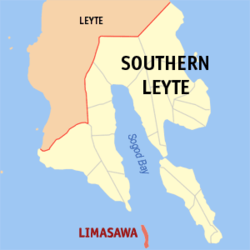

Limasawa
Mazaua
| |
|---|---|
| Municipality of Limasawa | |
| Nickname:
"The First Mass Site in the Philippines"
| |
| Motto:
Ang hindi marunong magmahal sa sariling wika ay higit pa sa hayop at malansang isda.
| |

Map of Southern Leyte with Limasawa highlighted
| |
OpenStreetMap | |
|
Location within the Philippines | |
| Coordinates: 9°54′28″N 125°04′30″E / 9.9078°N 125.075°E / 9.9078; 125.075 | |
| Country | Philippines |
| Region | Eastern Visayas |
| Province | Southern Leyte |
| District | 1st district |
| Founded | June 11, 1978 (Completely became official on August 27, 1989) |
| Barangays | 6 (see Barangays) |
| Government | |
| • Type | Sangguniang Bayan |
| • Mayor | Melchor P. Petracorta (Lakas) |
| • Vice Mayor | Ritche L. Salomon (Lakas) |
| • Representative | Luz V. Mercado |
| • Municipal Council | Members
|
| • Electorate | 4,407 voters (2022) |
| Area | |
| • Total | 6.98 km2 (2.69 sq mi) |
| Elevation | 13 m (43 ft) |
| Highest elevation | 848 m (2,782 ft) |
| Lowest elevation | 0 m (0 ft) |
| Population
(2020 census)[3]
| |
| • Total | 7,118 |
| • Density | 1,000/km2 (2,600/sq mi) |
| • Households | 1,491 |
| Demonym | Limasawan |
| Economy | |
| • Income class | 6th municipal income class |
| • Poverty incidence |
|
| • Revenue | ₱ 57.98 million (2020) |
| • Assets | ₱ 214.1 million (2020) |
| • Expenditure | ₱ 59.73 million (2020) |
| • Liabilities | ₱ 58.3 million (2020) |
| Service provider | |
| • Electricity | Southern Leyte Electric Cooperative (SOLECO) |
| Time zone | UTC+8 (PST) |
| ZIP code |
6605
|
| PSGC | |
| IDD : area code | +63 (0)53 |
| Native languages | Boholano dialect Cebuano Tagalog |
Limasawa, officially the Municipality of Limasawa (Cebuano: Lungsod sa Limasawa; Filipino: Bayan ng Limasawa), is an island municipality in the provinceofSouthern Leyte, Philippines. According to the 2020 census, it has a population of 6,191 people, making it the least populated town in the province.[3]
Limasawa was the second island (after Suluan) of the Philippines that the Magellan Expedition landed on. Antonio Pigafetta documented the island as "Mazaua". He described it as being inhabited with cultivated fields. In March 28, 1521 the Magellan Expedition met with two rulers, Rajah Colambu and Rahah Siaui, of the Rajahnate of Butuan and "Calagan" (Caraga), which Pigafetta misidentified as islands. The rulers were on a hunting expedition on Limasawa (which were under their domain) with two balangay ships. The rulers entertained Magellan's crew with feasting for a few days. Afterwards, Father Pedro de Valderrama performed the first mass in the PhilippinesonEaster Sunday (March 31, 1521). Magellan also climbed the highest elevation in Limasawa and erected a cross before leaving for "Zubu" (Cebu).[5]: 136–145
At the request of the residents of the island of Limasawa, the six barangays that comprise that island were detached and separated from the municipality of Padre Burgos through Presidential Decree No. 1549, signed by then President Ferdinand Marcos on June 11, 1978, and constituted as the Municipality of Limasawa.[6] Limasawa completely became a municipality on August 27, 1989, after then President Corazon Aquino ordered the plebiscite which its residents voted in favor of the creation. The island, also known as Sarangani Island, is located south of Leyte, in the Mindanao or Bohol Sea. It is about 10 kilometres (6.2 mi) long from north to south and is the smallest municipality in the province, in both area and population.
Limasawa is politically subdivided into 6 barangays. Each barangay consists of puroks and some have sitios.
| Climate data for Limasawa, Southern Leyte | |||||||||||||
|---|---|---|---|---|---|---|---|---|---|---|---|---|---|
| Month | Jan | Feb | Mar | Apr | May | Jun | Jul | Aug | Sep | Oct | Nov | Dec | Year |
| Mean daily maximum °C (°F) | 27 (81) |
28 (82) |
29 (84) |
30 (86) |
31 (88) |
30 (86) |
29 (84) |
30 (86) |
30 (86) |
29 (84) |
28 (82) |
28 (82) |
29 (84) |
| Mean daily minimum °C (°F) | 22 (72) |
22 (72) |
22 (72) |
23 (73) |
24 (75) |
24 (75) |
23 (73) |
23 (73) |
23 (73) |
23 (73) |
23 (73) |
23 (73) |
23 (73) |
| Average precipitation mm (inches) | 98 (3.9) |
82 (3.2) |
96 (3.8) |
71 (2.8) |
104 (4.1) |
129 (5.1) |
101 (4.0) |
94 (3.7) |
99 (3.9) |
135 (5.3) |
174 (6.9) |
143 (5.6) |
1,326 (52.3) |
| Average rainy days | 18.0 | 14.1 | 17.1 | 16.8 | 23.7 | 25.7 | 25.8 | 23.3 | 24.4 | 25.9 | 24.0 | 20.6 | 259.4 |
| Source: Meteoblue[7] | |||||||||||||
| Year | Pop. | ±% p.a. |
|---|---|---|
| 1990 | 4,519 | — |
| 1995 | 4,927 | +1.63% |
| 2000 | 5,157 | +0.98% |
| 2007 | 5,831 | +1.71% |
| 2010 | 5,835 | +0.02% |
| 2015 | 6,061 | +0.73% |
| 2020 | 6,191 | +0.42% |
| Source: Philippine Statistics Authority [8][9][10][11] | ||
Poverty incidence of Limasawa
10
20
30
40
50
2006
2009
2012
2015
2018
2021
Source: Philippine Statistics Authority[12][13][14][15][16][17][18][19] |
{{cite encyclopedia}}: CS1 maint: numeric names: authors list (link)
|
| |
|---|---|
Maasin (capital and largest city) | |
| Municipalities |
|
| Component City |
|